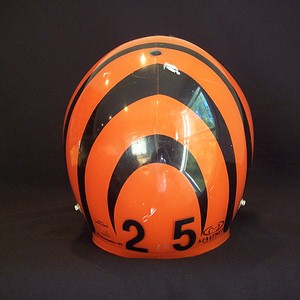
Bengals
John Simmons 1982 Super Bowl
(game worn)
Start with a clear shell. Apply, facing
outward, "model airplane" type or "waterslide" team logos and striping to the
inside of the transparent shell. Paint the inside of the shell in team colors
then apply a medium gray colored final sealer coat. Glue Velcro strips in
predetermined areas to the inside of the shell over the paint and install seven
separate sections of Velcro backed leather padding onto the Velcro strips.
Finally, snap in the leather jaw pads. The result is a glorious Maxpro clear
shell helmet that theoretically never needs repainting or team logos replaced
because they are permanently protected by the outside surface of the clear
plastic shell.
It has always been a treat to discover a Marietta Maxpro clear shell helmet
complete with team markings. These stunning helmets were produced in numerous
college and professional team designs during the 1970s and up until the early
1980s when the Marietta Corporation went out of business due to insurance cost
issues. Of all of the different team designs that we have experienced over the
years this is the very first Cincinnati Bengal Maxpro clear shell we have ever
seen, game used or otherwise, and this beauty made it all the way to the Super
Bowl!
The Maxpro clear shell helmet has been worn by some notable players during
past Super Bowls. Hall of Fame stars such as Roger Staubach, Randy White,
Terry Bradshaw and John Stallworth could easily be identified wearing this
interesting helmet in the big game. For the helmet aficionado, the Cowboys and
the Steelers teams of the 1970s are best remembered for both their numerous
Super Bowl appearances and their propensity for wearing the Maxpro clear shell
helmet. When we think of other Super Bowl teams from that era such as the
Dolphins, Vikings, Raiders and Broncos the image of Maxpro helmets does not
come to mind. Noting that Marietta, the company that produced the Maxpro
helmet, was based in Dallas it makes sense that they might have a closer
relationship with the Cowboys compared to other teams based on proximity
alone. It is less apparent why this helmet was so popular with the Steelers.
Perhaps Tony Parisi,
the legendary former Steeler's equipment manager, ordered Maxpro clear shell
helmets so that he could avoid replacing helmet logos and striping (Gee Tony,
the Steelers only used one decal per helmet anyway!). Parisi was known for
taping the backside of the facemask t-nuts to the inside of the shell the
helmet so that he could replace a facemask without having the t-nuts fall out
and having to replace them also. Instead of spending the extra time to apply
the round Steeler helmet decals without creasing them Tony would simply slit
the decals so that they would easily lay flat on the helmet. What was the
reason for ordering those Maxpros, Tony -- player or equipment manager
comfort?
In addition to seeing a more familiar Steeler or Cowboy clear Maxpro helmet
the always well informed Helmet Hut readers also love to savior that rare or
"oddball" variety. This month's featured helmet certainly fits
that description. This stunning Cincinnati Bengal clear shell Maxpro helmet
was actually worn in the 1982 Super Bowl by John Simmons (The Joe Montana led
Forty Niners won that game, their first Super Bowl victory, and they went on
from there to become the team of the 1980s). This was a most unique helmet
worn in a most unique setting. The 1982 Super Bowl was played for the first
time at a cold weather site -- Pontiac, Michigan. Fortunately, the game was
played indoors at the Silverdome as a severe winter ice storm paralyzed
the surrounding metropolitan area outside the dome. The Bengals had just
redesigned their helmets prior to the start of their Super Bowl season.
They replaced their conservative block style arched "BENGALS" logo that
original Bengals owner Paul Brown chose for the then new expansion team in
1968.
The new multi striped design was quite controversial; loved by some, hated by
others. Even today, this unorthodox design is a common topic of discussion
among helmet enthusiasts whenever the Bengals appear on television.
This helmet was manufactured in 1981 and has all the original leather
padding still intact. The number "25" rear helmet numerals are the correct 2"
tall, black colored, NCAA font style numbers that are still used by the
team. The facemask is also unique. It was introduced by Riddell in the 1977
and represents one of their many failed attempts to overtake the facemask
market from Schutt (see 1/14/2005 Dr. Dell Rye or click here:
http://www.helmethut.com/011305.html). This
was Riddell's stainless steel full cage version dipped in black vinyl. The
Bengals first started using Black colored masks in 1980 after switching from
standard gray. The upper portion of the vertical protective bar was sawed off
on this helmet's facemask to increase the players field of vision. The frugal
Bengals have always been known to primarily wear the Riddell facemasks that
come supplied on each Riddell helmet at no extra charge rather than substitute
the more popular Schutt facemasks that other teams purchase separately and
routinely use. If you look closely you will find that the team still wears
quite a few of those "no extra charge" Riddell masks.
The Maxpro clear shell helmet is a significant part of 1970s (and early
1980s) helmet history. This rare Bengals Maxpro worn in the Super Bowl by John
Simmons is certainly a very unique representation of that period and a
previously hidden treasure that we hope you will thoroughly enjoy.



